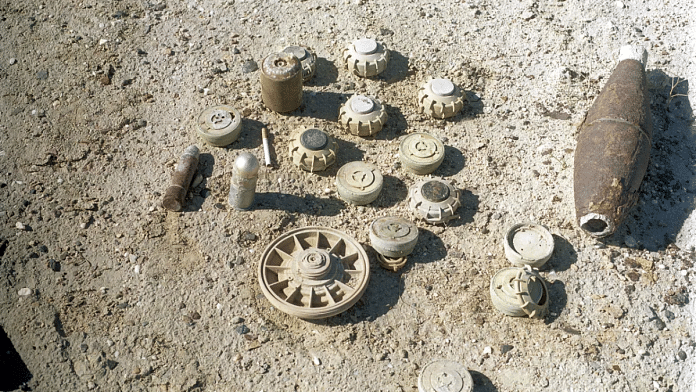New Delhi: Last week, Ukrainian President Volodymyr Zelenskyy initiated the process to withdraw his country from the Ottawa Convention as the war with Russia shows no sign of conclusion.
The above-mentioned treaty, also known as Anti-Personnel Mine Ban Convention, bans the production and use of indiscriminate anti-personnel mines that continue to maim and kill even after conflicts.
Zelensky further described anti-personnel landmines (APLs) as “often the instrument for which nothing can be substituted for defence purposes”. Russia, he said in a video, had never been a party to the convention “and is using anti-personnel mines with utmost cynicism” along with other weapons.
In June, the UN Mine Action Service said Ukraine was the most heavily contaminated country since the end of the Second World War. “UNMAS estimates that over 20 percent of land—or 139,000 sq km— in Ukraine is contaminated by mines or unexploded ordnances. Over six million people live in or around contaminated areas and over 800 casualties due to unexploded ordnances have been documented,” it said.
Often described as “the perfect soldiers,” anti-personnel mines—according to the Ottawa Treaty—are designed to be exploded by the presence, proximity or contact of a person and that will incapacitate, injure or kill one or more persons.
ThePrint looks at the Ottawa treaty and the related aspects surrounding the menace of anti-personnel mines.
How treaty came about
Ottawa Convention is an international ban on the use, manufacture, storage, and transfer of anti-personnel landmines. It also requires states to clean up mine-contaminated territories and destroy their existing landmine stocks.
The genesis of the Ottawa Convention was the humanitarian crisis caused by anti-personnel landmines. By the early 1990s, landmines were killing thousands of people every year, the vast majority of whom were innocent civilians.
According to the International Campaign to Ban Landmines (ICBL), more than 80 percent of landmine victims are civilians. Their hidden presence also prevented economic development, impeded refugee repatriation, and left huge swathes of land unusable. Increasing public awareness and tenacious campaigning by civil society organisations, notably ICBL and the International Committee of the Red Cross (ICRC), raised the issue to international level.
In October 1996, Canada launched a unique diplomatic initiative called the “Ottawa Process,” a fast-track, outside-the-UN negotiation aimed at a total ban of APLs. The negotiation brought together like-minded states, humanitarian organisations, and international organisations, and thus bypassed the traditional diplomatic body of disarmament conferences to fast-track the creation of the Convention.
The Convention was signed in Oslo, Norway on 18 September 1997 and opened for signature in Ottawa, Canada on 3-4 December 1997. It entered into force 1 March 1999. The treaty was a huge humanitarian effort to prevent the long-term impact of these hidden weapons.
It outlines the goals and responsibilities of all countries that join the treaty. The broad guidelines for the signatories include destroying all stockpiled landmines within four years after joining the treaty, cleaning all the lands contaminated with the landmines within 10 years after joining, and supporting the landmine victims by providing medical care, rehabilitation, psychological assistance, and reintegration into the society.
International cooperation to help each other to reach those goals is also encouraged by the treaty. The countries should share knowledge, resources, and even funds to help each other.
Until November last year, 164 countries had signed the Ottawa Convention. However, some major countries including the US, Russia, China, India, and Pakistan have not joined the treaty, citing national security. Although India follows the treaty’s rules voluntarily by limiting use of landmines or by not exporting them, it is not forbidden from using landmines as New Delhi is not a signatory to the treaty..
In its defence, India has said it needs to use landmines to safeguard its borders, especially from Pakistan, but always aligned with the principles of universal landmines treaty. The international watchdog Landmine Monitor said that India’s last major use of anti-personnel mines happened during Operation Parakram, between December 2001 and July 2002, when the Indian Army laid about two million mines along its northern and western borders with Pakistan as part of a military response to the Parliament attack.
Also Read: Global confidence in Trump’s leadership remains low, particularly among G7 allies, finds Pew survey
Wrong precedent to move out?
Did Ukraine’s withdrawal from the Treaty have opened the doors for other countries to pass by? Yes, the unfolding of the events suggests so.
“There are a bunch of countries that are already going out of the Ottawa agreement on using these kinds of landmines, it’s normal. It means that these countries are prioritising their national security and they are prioritising that it can be used in the context of potential warfare,” Victoria Vdovychenko, a defence expert at Cambridge University’s Centre for Geopolitics, told Al Jazeera.
On 18 March, Poland along with the three Baltic nations of Estonia, Latvia, and Lithuania stated in a joint statement that they “unanimously recommend withdrawing from the Ottawa Convention” and pointed toward Russia’s increasing security threats to NATO frontline states.
“Since joining the treaty, the security situation along NATO’s eastern flank has fundamentally deteriorated, and military threats to NATO member states bordering Russia and Belarus have significantly increased,” they said.
In April, Finland’s Prime Minister Petteri Orpo announced that there was no immediate military threat, but Russia poses a long-term danger to all of Europe, as his country shares the longest border with Russia, “Withdrawing from the Ottawa Convention will give us the possibility to prepare for the changes in the security environment in a more versatile way,” he said.
Two months on, the Finnish Parliament approved the withdrawal by a vote of 157–18 and acknowledged that Russia is “not a member of the Ottawa Treaty and uses landmines ruthlessly.”
Mannat Kaur is an intern who graduated from ThePrint School of Journalism
(Edited by Tony Rai)
Also Read: ‘Nones’ were 3rd largest group globally after Christians, Muslims in 2010-2020, finds Pew survey






